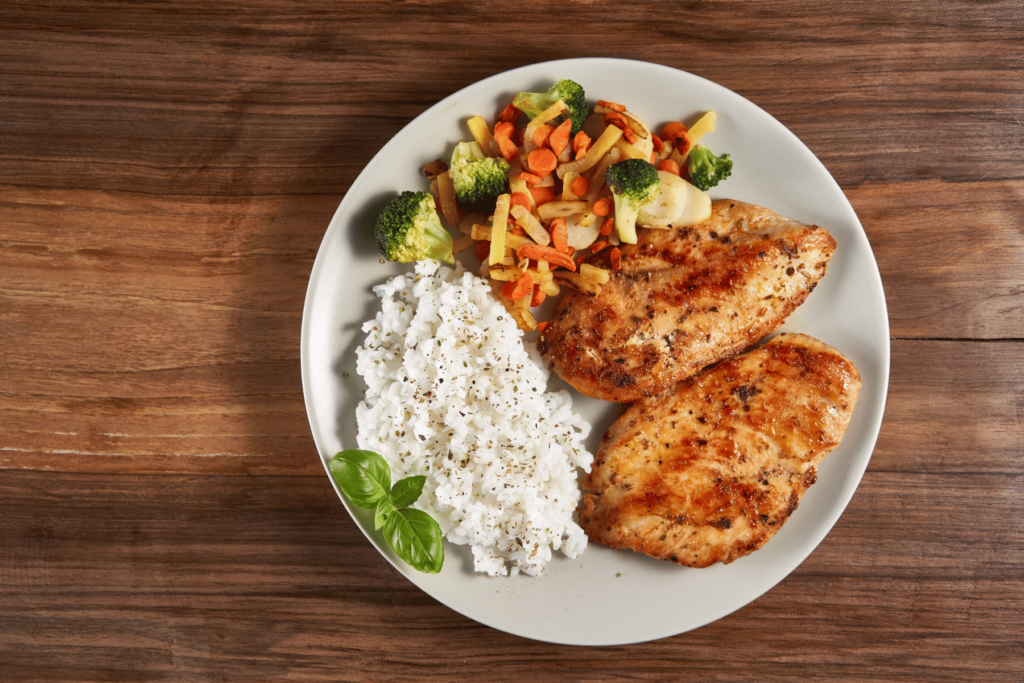Do you ever find yourself stuck between two tasty chicken options?
On one hand, there’s grilled chicken, a healthier option. On the flip side, you’ve got crispy, fried chicken.
It’s like an ongoing culinary debate that gets everyone talking.
Grilled Chicken vs Fried Chicken
In this blog post, I’m going to dig into the sizzling battle between grilled chicken and fried chicken.
I’ll share their nutritional stats, what makes them taste so darn good, the cooking methods to make each one delicious, and the various factors that influence our choices.
By the end of this ultimate guide, you’ll have a better idea of who takes the crown on your plate in the epic chicken showdown.

Grilled Chicken vs. Fried Chicken: Nutritional Value
When it comes to chicken, there’s a debate that goes beyond flavor and preparation – it’s all about nutrition.
Should you go for the sizzling, grilled chicken or opt for the crispy, fried goodness?
Let’s break it down in terms of calories, fat, protein, and how these choices impact your health.
Nutritional Differences
The first thing to consider when comparing grilled and fried chicken is how they’re prepared.
Grilled chicken is cooked by exposing it to an open flame or a high heat source, while fried chicken is submerged in hot oil, like olive oil or vegetable oil.
This main difference in preparation leads to distinct nutritional profiles.
Grilled chicken is the healthier option and best option for nutrient value.
It’s cooked without excessive oil, which means it retains more of its natural, lean goodness.
The grilling process allows excess fat to drip off, leaving you with a lower-fat, lower-calorie dish.
Plus, the absence of breading keeps those carbohydrates in check.
On the other hand, fried chicken is all about indulgence.
It’s typically breaded and then deep-fried, resulting in a crispy, flavorful exterior.
However, this also means it soaks up more oil during the cooking process, adding extra calories and fat to the final product.

Calorie, Fat, and Protein Content
Now, let’s dive into the numbers to see the different ways grilled and fried chicken stack up.
Calories
Grilled chicken is a winner in the calorie department.
On average, a 3.5-ounce serving of grilled chicken breast contains about 165 calories, while the same amount of fried chicken breast can pack around 250 calories or more, depending on the breading and frying method used.
Fat
Grilled chicken is notably lower in fat.
A 3.5-ounce portion of grilled chicken breast typically contains around 3.6 grams of fat, with much of it being the heart-healthy unsaturated kind.
In contrast, fried chicken can have up to 12 grams of fat or more, often of the less healthy saturated and trans fat varieties due to the frying process.
Protein
Both grilled and fried chicken are a good source of protein.
A 3.5-ounce serving of grilled chicken breast contains roughly 31 grams of protein, and fried chicken provides a similar protein punch.
Cholesterol and Heart Health
Grilled chicken’s nutritional profile makes it a better choice for heart health.
With its lower fat content, it’s less likely to contribute to the buildup of bad cholesterol in your arteries.
In fact, the lean protein in grilled chicken can help support your heart health.
Fried chicken, on the other hand, tends to be high in unhealthy saturated fats, which can raise your cholesterol levels and increase the risk of heart-related issues if consumed in excess.
The breading used in fried chicken can also add to the overall calorie and carbohydrate count, potentially affecting blood sugar levels.
When it comes to nutrition, grilled chicken takes the healthier path with fewer calories and less fat, making it a better option for those conscious about their health and heart.
While fried chicken is undeniably delicious, it’s best enjoyed in moderation as an occasional treat rather than a dietary staple.

Grilled Chicken vs. Fried Chicken: Taste and Texture
Beyond the nutritional considerations, let’s talk about the mouthwatering, sensory experience of these two culinary giants.
Taste and Texture of Grilled Chicken
Grilled chicken is all about simplicity and natural flavors.
When you take that first bite, you’ll encounter a smoky and charred exterior.
The skin, if left on, can become crispy, and the meat underneath remains tender and juicy.
It’s a clean and pure chicken flavor with subtle notes of smokiness.
The texture of grilled chicken is another highlight.
As you sink your teeth into the meat, it’s all about tenderness.
The slow grilling process helps retain the chicken’s moisture, ensuring it’s not dry or rubbery.
Taste and Texture of Fried Chicken
As you take a bite into a piece of perfectly fried chicken, the breading, typically seasoned with an array of spices, delivers a crispy, savory crunch.
The texture of fried chicken is the epitome of contrasts.
The outer layer is golden-brown and crispy.
As you delve further, the meat inside remains moist and tender.
Differences in Flavor and Mouthfeel
Grilled chicken offers a cleaner, more natural chicken taste with a touch of smokiness.
It’s all about the marriage of the smoky crust and tender meat.
The crunch is there, but it’s a bit more subtle.
Fried chicken, on the other hand, is a flavor-packed adventure.
The seasoned breading brings an array of spices to your palate, making every bite an explosion of taste.
The contrast between the crispy exterior and the succulent meat inside is a party for your taste buds.
The choice between grilled and fried chicken boils down to personal preferences.
Grilled chicken is the embodiment of simplicity, offering a clean, natural taste and a tender bite.
Fried chicken, with its crispy, flavorful breading and juicy meat, is an indulgent treat for those seeking an explosion of taste and texture.

Chicken Cooking Techniques
As chicken enthusiasts, we know the real magic happens in the kitchen.
But the age-old debate continues – should you fire up the grill for that smoky goodness or opt for an air fryer?
Cooking Techniques for Grilling Chicken
Grilling chicken is all about embracing the great outdoors (or your trusty indoor grill). Here’s how it’s done:
1. Preparing the Chicken: Before grilling, the chicken is typically marinated or seasoned to infuse it with flavor. You can use a marinade, dry rub, or simply some salt, pepper, and your favorite herbs and spices.
2. Grilling Process: The chicken is placed directly on the grill grates, often over an open flame or charcoal, and sometimes with wood chips for added smokiness. The key is to maintain a moderate heat and cook it slowly, turning occasionally to ensure even cooking.
Cooking Techniques for Frying Chicken
Now, let’s jump into the world of fried chicken, where the kitchen becomes your crispy playground:
1. Breading: Fried chicken starts with a little more prep. The chicken is typically coated in a seasoned flour mixture. This breading creates that famous crispy exterior.
2. Deep Frying: The chicken pieces are submerged in hot oil for a crispy, golden-brown finish. The oil should be at the right temperature to ensure proper cooking. It’s a faster cooking method compared to grilling.
Pros and Cons of Each Method
Grilling Chicken
Pros:
- Healthier Option: Grilling chicken is a leaner choice since it uses minimal cooking oil. The excess fat drips away during cooking.
- Smoky Flavor: The open flame or charcoal imparts a delightful smoky flavor.
- At-Home Barbecue: It’s an excellent choice for outdoor gatherings and cookouts.
Cons:
- Longer Cooking Time: Grilling chicken can take longer than frying, so it requires a bit more patience.
- Risk of Drying: Without careful attention, chicken can dry out on the grill.

Frying Chicken:
Pros:
- Crispy Crunch: Fried chicken is all about that irresistible crispy, golden brown breading.
- Speedy Cooking: It cooks relatively quickly in high temperatures, making it perfect for satisfying cravings.
- Versatility: The breading allows for endless flavor variations.
Cons:
- Higher Caloric Content: Due to the frying process, fried chicken tends to be higher in calories and fat.
- Messy Cleanup: Deep frying can create a bit of a mess, and you have to dispose of the used oil properly.

Grilled Chicken vs. Fried Chicken: The Health Benefits
As we navigate the world of culinary delights, one question keeps popping up – is grilled chicken the reigning health champion, or can fried chicken hold its own?
Below you will find the best way to explore the health considerations from the nutrition information to find the right balance for our dietary choices.
Health Benefits of Grilled Chicken
Grilled chicken can be a shining star on your plate for several reasons.
1. Lean Protein: Grilled chicken is packed with lean protein, making it an excellent choice for those looking to meet their protein needs without excessive fat. It’s a muscle-building powerhouse and helps you feel full and satisfied.
2. Lower Fat Content: The grilling process allows excess fat to drip off the chicken, leaving you with a lower-fat option. The fats that remain are often of the healthier, unsaturated variety, which can contribute to better heart health.
3. Versatility: Grilled chicken can be paired with a variety of side dishes, making it easy to create a balanced meal with plenty of veggies and whole grains.
Potential Health Concerns of Fried Chicken
While fried chicken can be an irresistible treat, it does come with a few health considerations:
1. Higher in Calories and Fat: Fried chicken tends to be higher in calories and unhealthy fats due to the deep-frying process. This can contribute to weight gain and increased cholesterol levels.
2. Processed Ingredients: The breading used in fried chicken may contain processed ingredients and preservatives, which are not always the best choice for your overall health.
3. Moderation: Eating fried chicken regularly can lead to health issues. However, enjoying it in moderation as an occasional indulgence can still be part of a balanced diet.
The Importance of Moderation in Dietary Choices
When it comes to choosing between grilled and fried chicken, the key is moderation.
It’s all about finding a balance that works for your lifestyle and health goals.
Here are a few pointers to consider.
- Variety is Key: Incorporate a variety of cooking methods and dishes into your diet to ensure you get a broad spectrum of nutrients.
- Mindful Eating: Be aware of portion sizes and listen to your body’s hunger and fullness cues. It’s okay to enjoy fried chicken but in sensible amounts.
- Occasional Treat: Reserve fried chicken as a special treat for those times when you’re truly craving it. This can help you avoid overindulging.
- Healthy Sides: Pair your chicken, whether grilled or fried, with nutritious sides like salads, steamed vegetables, or whole grains to create healthier meals.

In the end, the health considerations of grilled and fried chicken should guide your choices, but they shouldn’t prevent you from savoring the flavors you love.
It’s all about making informed decisions and embracing moderation to maintain a balanced and healthy relationship with your food.
So, whether you’re grilling or frying, here’s to enjoying your chicken while taking care of your health!

This comprehensive guide truly settles the age-old grilled vs. fried chicken debate! The nutritional breakdown is enlightening, emphasizing the benefits of grilled chicken for a leaner, heart-healthy option. The vivid descriptions of taste and texture make it a delightful read, celebrating the unique pleasures each method brings to the table. I appreciate the focus on moderation, recognizing that both grilled and fried chicken can have their place in a balanced diet. This piece not only informs but encourages a mindful and enjoyable approach to our culinary choices. Cheers to savoring the deliciousness while keeping health in mind!